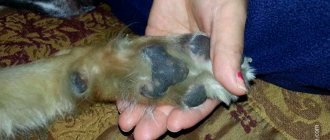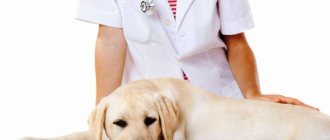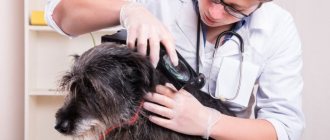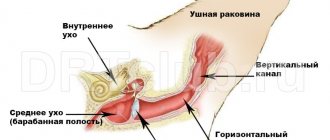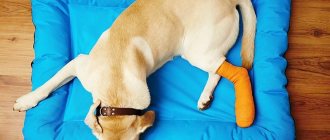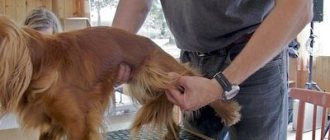What is a dislocation
In veterinary practice, joint dislocation in a dog is understood as an anatomical displacement of bone structures with damage to tissue integrity. The injury is accompanied by destruction of cartilaginous structures and blood vessels. The tendons and ligaments of the joint are involved in the pathological process.
According to its etiology, the disease can be congenital, for example, due to improper development of the fetus in the womb. With the development of atrophic processes in muscle tissue, the dog develops paralytic dislocation. The owner usually encounters a pathological type of injury against the background of the development of musculoskeletal diseases in the pet (rickets, osteomalacia).
Content
1. Causes of a sprained paw in a dog 2. How to identify the problem? 3. How to help at first?
Try to curb the riot of energy of a young, healthy, cheerful dog! And you shouldn't usually do this. However, sometimes the puppy’s inexperience or some external or physiological factors lead to the diagnosis of “dog sprained paw.”
And here people have a serious dilemma. On the one hand, the popular saying about “healing like a dog” did not appear by chance. Indeed, the animal body is very resistant to stress and damage, and they restore their functional conditions quite quickly.
On the other hand, the consequences of neglected sprains under certain conditions can be quite unpredictable, ranging from severe inflammatory processes, including lameness, to sepsis and death. As a result, you should not delay the start of the treatment process, and, if possible, quickly take your pet to a veterinary clinic.
Causes and signs of ligament tears in dogs
Sprains are most often caused by increased activity and mobility of the dog. Adult representatives of the canine family suffer from ligament injuries much less frequently than small fragile puppies. However, not a single animal, even the most experienced and old, is immune from tears and sprains. There may be several reasons for this:
- If we talk about small, very young dogs, their bodies grow quite quickly. Weight gain occurs rapidly. At the same time, the puppies are very mobile and clumsy, and their ligaments are still too weak to have time to adapt to the speed changes in the animal’s parameters. Therefore, ligament injuries often occur during vigorous jumping and running, which may be accompanied by falls. Excess weight is also dangerous for mature pets. The first thing that suffers from excess kilograms is the knee tendons;
- The cause of sprains in dogs of any age is a lack of vital microelements in the body, in particular calcium;
- Ligaments can also stretch after serious damage to a pet’s limbs, fractures or dislocations;
- The basis for the breakdown is the dog’s motor activity when overcoming any obstacle by jumping over or when climbing high steps of a ladder;
- Also, damage to the ligaments can be a congenital pathology of the puppy.
Experienced dog breeders and veterinary surgeons note two main reasons for the development of the disease in four-legged pets - congenital and traumatic. Congenital dislocations are most typical for representatives of dwarf breeds due to genetic hereditary predisposition and genetic marriage. In some cases, pathology is detected at the age of 6-8 months.
Veterinary surgeons often diagnose congenital dislocation of the patella in small breed dogs and incomplete dislocation of the hip joint. At the same time, miniature breeds such as toy terriers, Chihuahuas, and lap dogs have a genetic predisposition to pathology.
Most often, the first symptom that the owner of a four-legged dog pays attention to is lameness. The paw is intact, there are no cuts or splinters, but the pet reacts sharply to an attempt to feel or change the position of the joint. Possible causes of ligament injuries are:
- Excess weight of an adult dog, active growth of a puppy - connective tissues cannot support the weight of the pet, as a result of which even a light load can cause fiber ruptures.
- Age-related degenerative diseases.
Muscle strains in dogs treatment
Young dogs are often exposed to various injuries due to the fact that they are quite mobile, but their bodies are not yet adapted to significant stress. One of the most common pathologies of this kind is a sprain in a dog’s hind legs. This can happen to any animal, so it is very important to understand the causes of this problem, what symptoms you should pay attention to, and how to treat if the dog is injured. Knowing this information, you can easily restore your pet’s previous life within a few days, even if it was accidentally injured.
Ligament ruptures - types and symptoms
In terms of popularity, extremity injuries “lead”, with 70% of them being ruptures and sprains of the cruciate ligaments of the knee joints. The dog rests on only three paws, and holds the injured limb suspended, slightly bent at the knee.
There are several treatment options, but almost all involve surgery. Moreover, if conservative treatment methods are tried with pets weighing up to 12-15 kilograms, large dogs are operated on immediately, as the likelihood of re-injury is too high.
Cruciate ligaments (CL) consist of two intertwined flaps of fibrous tissue, one located on the front of the joint, and the second on the back. If one or both ligaments are damaged, the knee joint actually separates, the bone heads dislodge, rub, become deformed and tear the joint capsule.
Prolonged injury leads to deformation of the meniscus, hemorrhage into the soft tissues and extensive inflammatory process.
Diagnosis of a knee joint rupture is based on anamnesis, examination of the joint and x-rays, which are prescribed without fail. With a complete rupture, the picture is clear even without a picture, but the veterinarian must make sure that the injury is not complicated by a dislocation.
Sprain from a physiological point of view
A joint is a part of the skeleton that is responsible for flexion and extension of the limbs and shock absorption. The elastic fibrous tissue of the ligaments consists of many thin fibers and nerve endings that protect the bones from the “shock wave”, for example, when jumping. According to their functional purpose, ligaments are divided into:
- Fixing – fastening of internal organs in the body cavity.
- Guides – set the possible degree and direction of movement of the joint.
- Strengthening and braking - fix the joint, limit the maximum amplitude of flexion and extension, absorb shock.
Note! Each step of the dog is a body impact on the ground, accompanied by vibration. By shock absorption we mean that the joint and ligaments take on most of the load, protecting internal organs and muscles from vibration.
Symptoms of sprains and ligament tears in dogs
It is quite easy to notice a tendon strain. However, the dog may not react immediately after the rupture, and pronounced symptoms of injury will appear much later. The following indicates joint injuries, sprains and ligament ruptures in a pet:
- The dog became melancholy, sad, uncommunicative, and less active. Usually in such cases the animal holds the injured limb suspended, tries not to use the affected paw when moving, and limps;
- Swelling in the area of the damaged joint, swelling, and pain when touched are detected. Such symptoms may appear only 2 to 3 hours after the injury. If you pay attention to the dog before swelling appears, the presence of ligament rupture can be determined by touch.
- There are bruises in the area of injury. Blood during an injury may appear due to the fact that with a strong rupture, nearby blood vessels are damaged along with the ligaments. For this reason, hemorrhage can be observed in the tissues protecting the joints.
The owner can suspect a pathological process in the joint by paying attention to the following clinical picture in the pet:
- Refusal to step on the affected limb. The dog begins to limp, takes an unnatural position, and jumps on three legs.
- When a forelimb is dislocated, the injury is characterized by the animal pulling its paw under itself. If a dog has a hip dislocation, the owner will notice that it has difficulty getting up after sleeping or resting.
- The damaged musculoskeletal organ changes its anatomical configuration due to the development of tissue edema. The owner often observes swelling in the joint area.
- The mobility of the injured limb is limited. The dog tries to hold the limb, pointing it inward.
- Any touch, let alone palpation, causes severe pain in the animal. A painful reaction may be accompanied by aggression from the pet. The dog whines, squeals, growls, tries to move away from the owner and even tries to bite.
In some cases, symptoms of dislocation in dogs may include sounds of bone rubbing against the surface of the joint, clicks, and even grinding sounds.
Patellas in small breeds
Owners of Yorkies, toy terriers, and Spitz dogs often contact a veterinarian regarding lameness in their pets. The majority of these calls are for medial patellar luxation in dogs. The pathology is characterized by a displacement in the structure of the knee joint into the organ. Lateral displacement (outward) accounts for only 20-25% of calls.
Veterinarians distinguish 4 degrees of luxating patella in dogs. The most difficult case is grade 4, in which the kneecap cannot be adjusted without assistance.
Clinically, the disease is characterized by periodic lameness. The most informative diagnostic method is an x-ray examination of the joint, which is performed in direct and lateral projections.
Hip
One of the most common injuries in dogs is dislocation of the hip joint, accompanied by displacement of the head of the femur from its anatomical place - the acetabulum. The pathology is often complicated by rupture of the round ligament.
Clinically, hip dislocation in a dog is characterized by severe lameness. She does not step on the sore paw and constantly holds it up. The limb is directed inward. Severe pain leads to loss of appetite, accompanied by lethargy and apathy of the animal.
Hind and front paws
How to identify the problem?
Sprain and rupture of ligaments, as already noted, are similar in physiology and, accordingly, in symptoms. Among the signs of a sprained paw in a dog are the following:
- Lameness. It is clear that it is difficult for a dog to stand on a sore leg, so the animal will definitely limp.
- Swelling as a result of torn tissue fibers.
- Presence of pain. If you palpate, the dog will struggle and demonstrate in every possible way that he is in pain.
- As a rule, the limb is located in a suspended state. The pet simply does not step on her, and she seems to be dangling in the air in a half-bent state.
- Hematoma.
- An increase in temperature, as an inflammatory process automatically develops when a dog’s paw is stretched.
Causes of sprains
Often the cause of a sprain in a dog is excessive physical pressure on the joint of the limb. This phenomenon can be the result of an unsuccessful jump, fall, blow, body turn, and so on. In addition, there are so-called risk factors that increase the likelihood of ligament damage in cases where the physical impact on the joint does not exceed the permissible norm. In other words, even a slight jump or movement of the dog on the stairs can cause a ligament rupture.
These risk factors are:
- Rapid growth of large breed puppies. These representatives of the canine world always have the problem of uneven mutual growth of individual anatomical areas of the body. Bones always grow faster than muscles and tendons, which greatly disrupts the general physiology of movement. As a result, even minor impacts can tear ligaments in these dogs.
- Diet unbalanced in microelements. Calcium and magnesium are the main elements involved in the growth and physiology of the musculoskeletal status of not only young but also adult animals. With their deficiency, increased bone fragility and reduced elasticity of tendons and muscles are observed.
- Some congenital and acquired diseases, for example, rickets, significantly disrupt the body’s metabolism and thereby weaken the dog’s musculoskeletal system.
- Some anatomical disorders of bones and muscles. For example, improper fusion of the bone base after healing of an old fracture.
- Overweight animals.
- Climbing stairs. This is a particularly common problem among young animals kept in apartments in multi-storey buildings.
Hip dislocation in a dog
Hip dislocations are quite common due to the complex multi-axial structure of the hip joint itself.
In most cases (more than 95%), complete traumatic dislocation of the head of the hip joint occurs in dogs, and incomplete dislocation - that is, subluxation - is less common in dogs with joint dysplasia.
Traumatic dislocation of the hip joint leads to a complete inability to lean on the damaged limb, and the pelvic part becomes swollen and asymmetry.
A definitive diagnosis of hip dislocation can only be made after an X-ray examination.
Treatment of a dislocated hip joint should be done as quickly as possible after discovery of the disease by repositioning the dislocated joint or surgery. The most optimal period is the first hours after the injury; if you urgently consult a doctor during the first 24 hours after the injury, the specialist will be able to help you and correct the dislocation without surgery.
However, at a later stage, reduction of hip dislocation using the closed reduction method is not always successful, and relapse may occur when the femur comes out of the acetabulum again.
Therefore, the surgical method of treating this injury is most often used. The doctor will determine the method of recovery based on: the age of the animal, its weight, the characteristics of the breed, the severity of the dislocation and the appearance of associated injuries, and so on.
Medical practice recommends the use of four types of intervention and treatment for hip dislocation.
The first method of suturing the joint capsule is the so-called capsulorrhaphy. This option is necessary when there is a tear in the joint capsule, which stabilizes the hip joint. The method results in open reduction by tightly suturing the joint capsule, after which the animal requires strict rest for a period of two weeks.
The following methods are the round ligament replacement method and the transarticular stabilization method, in which the damaged hip joint is fixed in the correct anatomical position using a metal pin, which fixes the composition to the floor of the acetabulum. After this, the animal requires strict rest for a period of up to three weeks, and the metal pin is removed when this period is reached.
When replacing the round ligament, instead of a wire, a graft is inserted into the position of the round ligament, and the remnants of the round ligament are removed, along with which the joint capsule is sutured. The method also requires restricting the animal's movement for a period of two weeks.
The last surgical method for treating hip dislocation is removal of the femoral head, that is, the method of resection arthroplasty.
Recovery in the post-rehabilitation period requires first strict rest for up to 2-3 weeks, and then rehabilitation procedures such as physiotherapy and swimming. A small amount of exercise will help to gradually restore the animal's mobility.
Symptoms of injury
The symptoms of sprains are quite characteristic and easily recognizable. This is due to the fact that after an injury and rupture, an inflammatory process begins in the limb. Depending on its severity, veterinarians distinguish three stages:
- Easy. The dog feels only slight pain, since several fibers have been torn, and the rest are intact.
- Average. In this case, the gap is more significant and serious. It still preserves the overall integrity of the paw joint.
- Heavy. This case is considered the most unfavorable. It characterizes a complete rupture of the ligaments. Often this pathology occurs against the background of fractures and dislocations. That is why veterinarians classify it as a separate type of limb injury.
If we talk about signs and symptoms, then it is definitely worth highlighting the following complex:
- Lameness. The animal tries very carefully to stand on the damaged paw.
- Swelling of the paw tissue. Swelling can be seen at the site where the damage occurred.
- Painful sensations. The dog pulls out its paw when examined.
- A certain position of the limb. Most often, the animal will hold it in a half-bent, suspended position. This is due to the fact that the dog will be afraid of the pain that he can get from leaning on his paw. In some cases, if the gap is significant, you can even determine by touch where it occurred.
- Increased body temperature. This only applies to the site of the inflammatory process.
- Skin damage. This happens when you get injured.
- Hematoma formation. This rarely happens when blood vessels are affected. If your dog has one or more of the above symptoms, you should contact your veterinarian.
Patella luxation
This type of dislocation most often occurs in small and dwarf breeds of dogs, such as terriers and Spitz, poodles, as they have a genetic predisposition to such a dislocation.
Dislocation of the calyx as a result of injury occurs in larger breeds of dogs. Also, the displacement of the kneecap is often associated with age-related changes, since closer to old age the muscles of the body weaken and this type of injury is possible.
When a dog's kneecap dislocates, it can move both outward and inward - if the kneecap moves toward the abdomen, then this type is called a lateral dislocation, and in the opposite direction from the abdomen, it is a medial dislocation.
The last type - medial dislocation - is more common, small breeds of dogs are most susceptible to it, and for dwarf breeds it poses the greatest threat, as it can lead to irreversible consequences and the dog will lose mobility.
Classification
In order to diagnose a dislocation and determine treatment, it should be taken into account that doctors distinguish 4 degrees of severity of patella dislocation in dogs:
The first degree is the easiest; after a knee injury, the cup will return to its place without consequences
The second degree is characterized by an unnatural position when bending, and may fall into place in rare cases
The third degree occurs during movement when bending and extending the paw; it requires surgical intervention, as it gets into place for a short time and loses its position again

